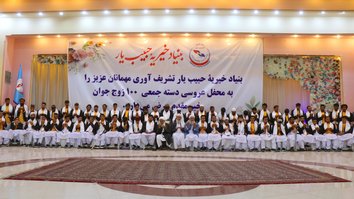HERAT -- Salma Dam -- operating at full capacity for the first time -- is providing electricity to Herat city and irrigation water key to the survival of crops.
All three of the dam's turbines have been operational since May 5, according to Barakatullah Rahimi, the technical director of the dam.
With all three turbines operational, the dam is providing more than 40MW of electricity to the Herat city grid, he said.
This is the first time that all three of the dam's turbines are simultaneously operational, except for testing two years ago, Rahimi said, adding that agricultural lands will benefit greatly.
![In this photograph taken May 5, Salma Dam is seen in Chishti Sharif district, Herat province. [Omar/Salma Times]](/cnmi_st/images/2022/05/24/35499-s_1-585_329.jpg)
In this photograph taken May 5, Salma Dam is seen in Chishti Sharif district, Herat province. [Omar/Salma Times]
![Two farmers work on their rice farm May 18 in Injil district. [Omar/Salaam Times]](/cnmi_st/images/2022/05/24/35500-s_4-585_329.jpg)
Two farmers work on their rice farm May 18 in Injil district. [Omar/Salaam Times]
"Eighty cubic metres of water per second is discharged from Salma Dam's turbines and provided to Herat's agricultural lands," he said.
Abundant rainfall this year helped fill the dam's reservoir.
"There is more water in the Salma Dam reservoir this year than last year," Rahimi said. "There will be enough water for irrigation in the spring and summer."
The dam provides irrigation water to agricultural lands and orchards in eight of Herat's 19 districts -- Chesht, Obe, Pashtun Zarghun, Guzara, Injil, Zindajan, Ghorian and Kohsan.
"We will provide sufficient amounts of water to agricultural lands and orchards covered by the dam as long as they need it," said Sardar Wali Muzamil, director of the Herat River Basin.
"Water will be distributed to farmers based on a specific schedule," he said. "Not even a single drop of water goes out of the country."
India funded the construction of Salma Dam -- also known as the Afghanistan-India Friendship Dam -- and it became operational in 2016.
Prior to the dam's construction, water from the Harirud River flowed freely into Iran. Disgruntled by the loss of free water, the Iranian regime through its proxies has tried to block or sabotage the construction of several dams in Afghanistan's western region.
Now, Salma Dam has the capacity to generate 42MW of electricity, store 633 million cubic metres of water and irrigate 75,000 hectares of land.
Rescuing farms from drought
A number of farmers in Herat say their crops would have perished had it not been for Salma Dam.
"Salma Dam has been providing water to farms in the dry season for almost a month now and has saved our crops," said Mohammad Barekzai, 45, a farmer in Injil district.
"I have cultivated wheat and rice on one hectare of land this year," he said. "My entire crop would have died had it not been for water from Salma Dam."
Nazar Mohammad, 49, another wheat and rice farmer in Injil district, said his crops died last year from water shortages. This year there is sufficient water, and he expects to have good yields.
"Salma Dam has saved my crops and and all other farmers' crops in the district from dying," he said.
"Our crops would have died in a few days and our efforts would have been in vain if the water had not been provided."
"Wheat crops were close to harvest and needed one last round of irrigation," he said. "We all irrigated our wheat fields after water from Salma Dam arrived, and we will harvest wheat in a few days."
Gul Ahmad, 48, a rice farmer in Injil district, said he is happy the dam is providing sufficient water for farmers' crops.
"Paddies must be in water for 24 hours until they are grown," he said. "Paddy crops would die without enough water."
Increase in yields
Herat's Directorate of Agriculture, Irrigation and Livestock (DAIL) has projected grain and fruit yields to increase significantly this year compared with last year, thanks to available water.
"Wheat and other grain crops are ripe, and harvests have begun in some districts," said Pir Mohammad Halimi, director of the directorate. "Comparing this year's wheat yields with last year's, it is 50% higher this year."
"There are more than 3,000 fruit orchards in eight Herat districts covered by water from Salma Dam," he said.
Water from the dam has greatly helped Herat farmers' economic situation, and as a result poverty among farmers is expected to decline, Halimi said.
Over the past seven years, Salma Dam has transformed farmers' lives in most districts of Herat, said Bashir Ahmad Ahmadi, an agricultural specialist in the province.
Had it not been for this dam, Harirud River water would have flowed into Iran, while crops in Herat would have died this season, he said.
"The volume of snow and rainfall this year was higher, and there is a lot of water behind Salma Dam," he said. "Therefore, agricultural yields will be higher as well."
"In the western districts of Herat such as Zindajan, Ghorian and Kohsan, where much saffron is cultivated, water from Salma Dam plays a key role," he added.








I wonder why the United States has cut the budget for building the Pashdan dam!!! We all know that poverty is the mother of terrorism. If Americans are really concerned about the growth of terrorism in Afghanistan, it is enough to financially support the construction of the dam. With the construction of this dam, tens of thousands of people will get jobs to earn a living for themselves. Also they won’t be recruited by the terrorist groups, they won’t migrate and other countries won’t be able to use them as their proxy soldiers. When terrorist organizations fail to recruit fighters in Afghanistan, their capacity would be automatically weakened and they would no longer be able to threaten United States' security. This is not only affordable for the US government but is a huge saving in costs.
Reply6 Comment
This is a great news. Besides Salma Dam, the construction of another large dam in Herat province was underway and it was scheduled to be operated by the end of 2021. The dam, known as Pashdan Dam, is located in the Karukh district of Herat province, and according to officials, its construction was more than 60% completed during the Republic. With the collapse of the republic, the construction of this dam like many other development works in the country is suspended. Pashdan is the second largest water dam in Herat after Salma and has the capacity of 45 million cubic meters of water. In addition to irrigating about 13,000 hectares of agricultural land, the dam will also generate two megawatts of electricity, and if operated, most districts of Herat will benefit from agricultural water and the production of agricultural products will also increase. We expect the officials of the current government of Afghanistan to resume the suspended work on the dam as soon as possible.
Reply6 Comment
After reading this news, one can easily understand the difference between the Republic and the authoritarian regimes that came to power due to the intervention of the enemies; Afghanistan's neighbors. The Mujahideen destroyed all the country's foundations in the 1980s and 1990s at the request of Pakistan, including many water and power dams. At the same time, before the recent fall of the Republic, work was underway on three large and small water dams across the country, which would have significantly enhanced the country's agricultural sector. The secret would have been to generate a lot of electricity. Still, unfortunately, the Republic was overthrown due to an international conspiracy, and I don't think we should witness the opening of other dams like Salma in our lifetime.
Reply6 Comment
May the enemies of Afghanistan burn. Our beloved Afghanistan is not only rich in natural resources, but also it has abundant fresh water, the price of which will be higher than oil in the near future. Unfortunately, Afghanistan has not been able to consume any of its abundant natural resources. During the winter, the Afghans are suffering from the mud caused by snow. In the spring, it is the Afghan people whose homes and farmland are being destroyed by floods and in the end, this water, which has flowed into the rivers at the cost of the lives and property of the Afghan people, goes for free to the neighboring countries who have nothing to do but destruction and hypocrisy and spend all their time to make destructive plans for Afghanistan. Additionally with all these rivers, Afghanistan is still not able to supply even the electricity it needs for its homes and should import electricity from other countries. Imagine if there was only one power dam in each province like Salma, where would Afghanistan be? Alas, if we ourselves could understand the value of this country.
Reply6 Comment
Thank you so much for publishing such promising reports. I would like to shed some light on the background of the Kamal Khan Dam and the technical structure of this dam for the information of the readers. Background of Salma Dam: The first idea for the Salma Dam came to the then Prime Minister Musa Shafiq when he paid an official visit to Iran in the year 1968. However, the scientific research, design, and construction of this dam were completed by an Indian company during the presidency of the martyred Sardar Mohammad Daud Khan. The practical work of its construction started in the year 1976. However, the coup d'etat of the year 1978 halted the work of this vast and vital project even though 25% of the work on the dam had been completed. It suffered heavy losses during the Soviet invasion and civil war, and much of its equipment was stolen. After much effort by the Afghan government, India once again pledged its support for the dam's construction, and the foundation stone was laid for the second time on March 15, 2008. Work on the dam was completed after a 40-year delay with the financial and technical assistance of $275 million from the Government of India. It was officially inaugurated by Indian Prime Minister Narendra Modi and Afghan President Ashraf Ghani on June 4, 2016. The Salma Dam is one of Afghanistan's most significant power and irrigation dams. It is 20 km long and 7 km wide. At the height of 107 meters, the dam can store 633 million cubic meters of water and gen
Reply6 Comment
I thank the Salaam Times for publishing such good news. The morale of our people has been crushed; Afghans are deeply depressed and suffering from mental disorders. Don't spread depressing news. Such news can help strengthen people's morale. Thanks again.
Reply6 Comment